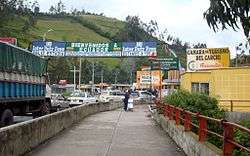Rumichaca Bridge
The Rumichaca Bridge (Quechua rumi stone, chaka bridge,[1] "stone bridge") is the principal highway passage between Colombia and Ecuador. The bridge is located 3 kilometres (1.9 mi) from the city of Ipiales, Colombia and 7 kilometres (4.3 mi) from the city of Tulcán, Ecuador.[2] The bridge is located in the Andes at an elevation of 2,763 metres (9,065 ft).[3] The Pan-American Highway crosses the bridge.
A natural stone bridge crosses the Carchi River here. The stone bridge is often called the "Inca Bridge." The Carchi River was called the Angasmayo by the Incas and early Spanish colonists. The bridge, according to Spanish chroniclers, was the northernmost outpost of the Inca Empire, wrested from the Pasto people in the early 16th century. Atop this natural bridge are the old Colombian and Ecuadorian customs houses. Prior to the completion of the modern bridge in 1973, the stone bridge was used as a border crossing for goods and people.[4]

The modern bridge, 80 metres (260 ft) upstream from the stone bridge is the most important artery for commerce and the transport of goods between Colombia and Ecuador. In 2013, 57.9 percent (about USD one billion) of Colombia's exports to Ecuador crossed the border on the Rumichaca Bridge. In the same year, 77 percent (about US$650 million) of Ecuador's exports to Colombia crossed the Rumichaca bridge.[5]
The years of 2017 and 2018 have seen increasing flows of Venezuelan citizens across the Rumichaca Bridge. Through July 30, 2018, an estimated 547,140 Venezuelans have crossed over the Rumichaca Bridge in transit to Ecuador, Peru, Chile, and Argentina. An estimated 88,814 persons stayed in Ecuador, while the other 458,326 left, mostly going to Peru and Chile.[6] The Venezuelan migrants are fleeing hunger and hyperinflation occurring in their country.
References
- Teofilo Laime Ajacopa, Diccionario Bilingüe Iskay simipi yuyayk'ancha, La Paz, 2007 (Quechua-Spanish dictionary)
- Casas Gragea, Angel Maria and Orbes Revelo, Belky, "Border Integration and Land Transport of Merchandise between Colombia and Ecuador", p. 56, http://www19.iadb.org/intal/intalcdi/integracion_comercio/i_INTAL_IYT_38_2014_CasasGragea_Revelo.pdf, accessed 1 June 2017
- Google Earth
- Almeida Reyes, Dr. Eduardo (2015), "El Camino del Inca en las Sierra Norte del Ecuador y su Valoracion Turistica", Revista de Invetigacion Cientifica, No, 7, pp. 75-87
- Casas Gragea and Orbes Revelo, p. 57, http://www19.iadb.org/intal/intalcdi/integracion_comercio/i_INTAL_IYT_38_2014_CasasGragea_Revelo.pdf, accessed 1 June 2017
- "Acnur: 30 000 ciudadanos venezolanos llegaron a Ecuador en la primera semana de agosto del 2018". El Comercio (in Spanish). Retrieved 2018-08-18.